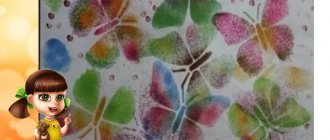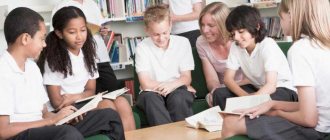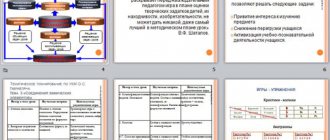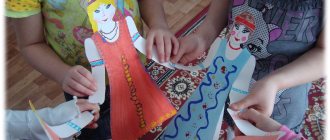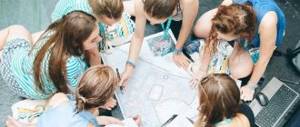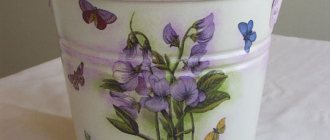Development of creative activity of students in technology lessons in extracurricular activities
Accustom the student to work, make him not only love work, but become so familiar with it that it becomes second nature to him, accustom him to the fact that it is unthinkable for him otherwise than to learn something on his own, so that he thinks and develops on his own. I'm a resilient person. (A. Disterweg)
“Creative work is possible only when a person treats work with love, when he diligently sees the joy in it, understands the benefits and necessity of work, when work becomes for him the main form of manifestation of personality and talent.” A.S. Makarenko “Education at work”
In order to introduce students to creativity, a well-thought-out system of aesthetic education in technology lessons is needed, which helps to develop the artistic taste of students, teaches them to understand folk art, and encourages them to build a life according to the laws of beauty.
Students only truly experience the joy of work when they create beautiful products with their own hands. To achieve this position, students must have a clear understanding of what a job well done looks like. The manufactured product must meet its purpose and manufacturability. At the same time, by manufacturability we mean the most rational and affordable way to manufacture individual parts or the product as a whole.
Children tend to want to introduce something new and see the results of their own search. By translating their ideas into specific products, students, overcoming difficulties, become convinced of their capabilities.
This is the second year we have been working on the new Federal State Educational Standards curricula. The authors of the textbook are N.V. Sinitsa, V.D. Simonenko “Technology. Technology of housekeeping" - M.: Ventana-Graf, 2013.
The educational result of classroom and extracurricular activities is the direct spiritual and moral acquisition of the child through his participation in one or another type of activity. 1. Demonstration of creative activity of students in the classroom.
For example, in 5th grade: in the first section “Interior Decoration” we carry out a creative project “Planning a kitchen-dining room”. Girls love this theme. First, sketches of the project are made in a notebook and in an album. Let's get acquainted with the types of layouts and color schemes in the kitchen. Then practical work is done. Some projects are done very well, with the participation of parents.
In the second section: “Cooking”, we are carrying out the project “Preparing Sunday breakfast for the whole family.” Topic: “Table setting” - when I talk with children about table setting and rules of behavior, I explain that deliciously prepared food gives pleasure only if the table is beautifully set.
The tablecloth must be clean; when selecting it, you must take into account the combination with the dishes. An interesting task is to create a menu, for example: rice porridge, cocoa with milk, a sandwich with butter and cheese. Students show interest and creativity in this work.
Topic: Shape of cutting vegetables. During cooking lessons I show how to cut vegetables. Knowing the form of cutting vegetables, students independently make from vegetables and other products: pig, rooster, mice, giraffe, fungus, flowers, etc.
Homework: surprise your relatives at home - prepare any dish and decorate it beautifully. After which parents, having tasted this dish, write reviews and give their children a rating. The reports introduce interesting recommendations and recipes.
2.Creation of products from textile materials. Materials Science.
In classes on the topic “Materials Science”, schoolchildren get acquainted with textile fibers and types of weaving.
For example, 5th grade - topic: “Production of textile materials.” Objective of the lesson: To form an idea of fabrics as two systems of warp and weft threads. The result of the lesson is laboratory and practical work.
In grades 5-7 there is a section “Design and modeling of clothing”.
Clothes design is one of the main areas of organizing students’ creative activities. When studying the design of garments, we make drawings of aprons, skirts, nightgowns, dresses, and blouses. Drawings are made on a scale of I: 4 and in M 1: 1. We pay great attention to the development of graphic skills, to the correct design of drawings in accordance with GOST requirements, and we also develop practical skills when taking measurements. Thus, students gain knowledge about scales, rules for taking body measurements and recording them correctly; about the allowances taken into account when constructing product drawings; forms of calculation and drawing.
An interesting topic is modeling based on a manufactured drawing - changing and improving the shapes of various structural elements and parts of a product. Here you can change the shape of parts (for example, pockets, collar). Clothes modeling classes are a complex, labor-intensive process that requires special knowledge, creative imagination, and artistic taste. When studying modeling, students receive educational information about the history of the development of clothing, its classification, and the features of the development of models in accordance with the purpose of clothing, the season, and the human figure. Students get acquainted with the work of an artist-fashion designer, learn to select fabric for the designed model.
- Manufacturing of garments.
When choosing fabric for sewing products, we take into account the suitability of the material for its purpose and the individual characteristics of each. When explaining, we use illustrations, posters, videos, and visual aids. We emphasize that the basic tone of the fabric should be in harmony with the color of the skin, eyes, and hair. Brunettes and brown-haired women are suitable for fabrics in light and bright colors, for example: yellow, light orange, soft pink, white, light green, beige, gray, red. And blondes go for blue, green, light purple, red and purple colors, depending on their complexion.
Open it up.
A very important operation is cutting. It requires not only knowledge and skills, but also creativity. Students independently lay out the pattern on the fabric. The results of active creative activity are the production of various forms of products. Depending on the age of the students, cutting and sewing products becomes more complicated. For example, 5th grade girls are engaged in making aprons; Class 6 – products based on a nightgown pattern (dress, blouse, robe); 7th grade – skirts.
Processing of garments.
The students' interest is maintained throughout the entire work - from the beginning of sewing to the final finishing. Here, schoolchildren are required to perform precise and careful technological processing of the product.
It is important to teach how to correct deficiencies identified during fitting. During lessons we use visual aids: a table for eliminating the main shortcomings of a straight skirt identified during the fitting process. An introductory briefing on safety precautions when working with cutting and piercing objects (needles, pins, scissors) is required. When preparing a skirt for fitting, students try it on in pairs and eliminate any shortcomings.
In 5th grade - topic: “Sewing an apron. Processing the ends of the belt." The purpose of the lesson is to repeat the overcast seam, its purpose, and its difference from the stitching one. Learn how to process a belt and its ends. During the lesson, I give an introductory briefing on safety precautions when working on a sewing machine. The students' task is to properly process the belt, first sweeping away these parts by hand.
6th grade – topic: “Shoulder product. Processing darts, shoulder and side seams.” The purpose of the lesson: to supplement and systematize knowledge about methods of joining and processing parts, taking into account the intended purpose of the product and fabric. I use seam samples as visual aids.
Final finishing.
At the final stage of processing the product, I pay attention to its final finishing. The artistic design of a product using finishing materials or embroidery and appliqué is always of interest.
8th grade – topic: “Decorative and applied arts. Embroidery”, modern technical tools are used in lessons, we demonstrate presentations and visual aids.
If difficulties arise in work, then the teacher’s task is to help children cope with them.
We transfer the design onto fabric using tracing paper and carbon paper. Students independently embroider with different types of stitches based on the chosen design.
A creative attitude to work is also fostered when discussing finished products. Students in technology lessons embody their creative ideas in specific products.
After completing the assignment, students work in pairs to check the quality of their classmates' products. In each class we conduct a “Defense of Creative Projects” on selected topics and an exhibition of student work.
4. Teacher’s creativity to achieve this goal.
I try to encourage children to show creativity, imagination, and invention, but I also strive to ensure that my lessons are interesting for students. For this purpose I offer: crosswords, puzzles, rebuses, riddles, anagrams, games on topics.
In my lessons I use the teacher's manual I.P. Arefieva "Entertaining technology lessons for girls." M.: School press, 2005. (“School and production. Magazine library”).
The creative activity of students is evident in all sections of the Technology program. Recently, the issues of “pedagogy of cooperation” and “pedagogy of co-creation” have been widely discussed. We are talking about the active position of the teacher and student in a common desire to achieve a noble goal - the comprehensive harmonious development of the individual.
To form a student’s creative personality, I try to use all the methods available in modern didactics:
- Explanatory and illustrative: story, explanation, experiments, tables, etc. This helps schoolchildren develop knowledge about the basic elements of production, materials, equipment, technology, labor organization and human labor activity.
- Reproductive (reproducing) These methods contribute to the development of practical skills in students.
- Problem-search: problem presentation, partially search, research.
When choosing teaching methods, I focus on those that stimulate the cognitive and practical activities of students, expand their polytechnic horizons, form practical skills, and contribute to the formation of a creative personality. When preparing for a lesson, I think about what methodological techniques I will use to develop attention, memory, observation, imagination, and morality of schoolchildren in this lesson.
In modern school practice, various pedagogical technologies are used to enhance the creative abilities of students. In the process of project activities, students develop their creative potential and learn the fundamental principles of constructing modern technologies. The most effective in an educational sense are:
- project method;
- use of modern TSO in lessons.
The project method is a didactic tool that promotes the formation of goal-setting skills and allows students to find optimal ways to achieve stated goals with appropriate guidance from the teacher.
Increasing technological literacy and creating sustainable interest among students in this form of learning is an important pedagogical task. Through the project method, it is possible to establish strong connections between students’ theoretical knowledge and their practical transformative activities. The humanistic orientation of students’ activities based on taking into account the human factors of creation creates the prerequisites for the formation in schoolchildren of such personality qualities as determination and will in the process of introducing their own developments into practice. Thus, new information technologies, used methodically correctly, increase the cognitive activity of students, which undoubtedly leads to increased learning efficiency.
A creative project is the result, the result of some independent work. The assessment of the project will depend on how accurately and clearly the technological operations were carried out, and how completely and firmly the acquired knowledge was assimilated. During the lesson, as a rule, the teacher or students practice speaking using a computer, projector, speakers, and presentations. The presentation can be structured in such a way as to most optimally solve the problems posed in the lesson. The presentation allows the teacher not only to give a lecture, but also to conduct a conversation with students, asking questions on the topic - thereby forcing students to update knowledge previously acquired in other subjects, make assumptions (Which of these drinks do you think is the most common, the most ancient ?), analyze the information received (variety of varieties of tea, types of coffee), compare (how the varieties and types of tea, coffee differ), generalize (Laboratory work. Determination of the properties of different types and varieties of tea), draw conclusions (what chemical elements are included in the hot drinks and how they affect the properties of these drinks, what properties the drink has), thereby developing the thinking of students, activating their cognitive activity. Conversation activates students, develops their memory and speech, opens up students' knowledge, has great educational power, and is a good diagnostic tool.
Experts have long noticed, based on the results of numerous experiments, a clear, strong connection between the method by which a student learned material and the ability to recall (restore) this material in memory. For example, only a quarter of the material heard remains in memory. If the student has the opportunity to perceive this material visually, then the proportion of material retained in memory increases to one third. With combined influence (through vision and hearing), the share of the material learned reaches half, and if the student is involved in active actions in the learning process, the share of the material learned can be 75%. For example, in a 5th grade lesson on the topic “Hot Drinks”, the element of entertainment is the legends about human discoveries of these drinks, implemented on presentation slides in the form of drawings, photos, text and musical accompaniment - this is new material in the lesson.
In the lesson “Household sewing machine. The history of the creation of the sewing machine" - videos are shown about the history of the creation of the sewing machine and the capabilities of modern sewing machines.
In the 6th grade on the topic “Fabrics from natural fibers” - showing a presentation about fibers of plant origin and when studying new material about fibers of animal origin.
In grades 7-8 on the topic “Fashion, styles, silhouettes” - students receive additional entertaining information about the development of people’s ideas about fashion, about the various silhouettes that were fashionable in different eras. There is an opportunity to introduce students to the activities of great couturiers such as Chanel, Dior, etc., and attend fashion shows of famous Fashion Houses.
Emotional experiences cause surprise techniques. The unusualness of the given fact, the paradoxical nature of the experience demonstrated in the lesson, the grandeur of the numbers - all this invariably causes deep emotional experiences in schoolchildren. For example, the message that tea as a drink was known as early as 3000 BC, and appeared in Russia in the 17th century; coffee was prescribed by doctors as a cure for “the blues and bad mood”, chocolate received its name from the almighty Aztec god Chocoatl and drank it, chocolate bars appeared on sale in 1659, “Black as night, hot as fire, pure as an angel, sweet, like the kiss of love” - these words are a vivid description of the properties of coffee, silk fiber is produced by the pupae of an inconspicuous-looking butterfly called the silkworm, the raw materials for many modern fabrics are gas, coal and wood, etc.
The final stage of the creative project: calculating the cost of the product, taking into account the funds spent on the materials used. Comparison of the cost of a handmade product with the cost of a similar product in a store.
- analysis of economic calculations (whether it was possible to save the family budget);
- calculate direct material costs (for the purchase of fabric, threads, needles, hoops, etc.);
- indirect (for energy consumption when lighting your workplace).
Effectiveness of experience
For 10 years, I have used these and other techniques to enhance the creative activity of schoolchildren in the classroom and during extracurricular activities, which I used at different stages of education, and tried to coordinate with the topics of the sections of the course being studied.
While working on developing children’s creative abilities, I noticed how they developed a strong interest in technological creativity. The level of independence, inventive activity, and skill of students has increased, and the results of the influence of such work on children have appeared. For students, the motive has become the norm: “If I can do this, then I can do other things.” And if we want to see our children as comprehensively developed, creatively free individuals, then, when coming into contact with them, we must be able to understand their motives and needs and skillfully direct the course of their development.
Technological creativity has become available to almost all students. But the characteristics of the personal development of individual students may sometimes require the use of various types of assistance on the part of the teacher, activating motivation for technological creative project activities.
Expected result: 1. Unlocking the creative potential of schoolchildren, increasing the level of spirituality; knowledge of safety rules when working with various art materials; high-quality DIY crafts; careful attitude to natural and artistic materials; ability to apply theoretical knowledge in practice; 2.Formation of communicative competencies.
The educational effect of extracurricular activities is the influence of one or another spiritual and moral acquisition on the process of development of the child’s personality.
Results of extracurricular activities:
- development of an individual who is careful about the environment, with a sense of responsibility and self-confidence, possessing work culture skills with a positive attitude towards work;
- formation of a support system of knowledge, subject-specific and universal methods of action that provide the opportunity to continue education in primary school;
- nurturing the ability to learn—the ability to self-organize in order to solve life problems;
Individual progress develops in the main areas of personal development - emotional, cognitive, self-regulation.
V. A. Sukhomlinsky was right: “There is no and cannot be education without labor and without labor.”
Development of students' creative abilities in elementary school lessons.
Author: Morozova Natalya Gennadievna
Development of students' creative abilities in elementary school lessons.
The main tasks of education and personality development include the education of basic culture and the comprehensive development of students’ personal potentials. One of the components of personal potential is creativity. With its development, cognitive interest in the subject increases, the level of intellectual development, the degree of independent thinking, interest in performing search tasks, qualities such as curiosity, self-confidence, and confidence are formed.
Creative activity develops in the process of activities of a creative nature, which forces students to learn and be surprised, to find solutions in non-standard situations.
Therefore, today in pedagogical science and practice there is an intensive search for new, non-standard forms, methods and techniques of teaching. Non-traditional types of lessons, problem-based teaching methods, and collective creative activities in extracurricular activities are becoming widespread, promoting the development of creative activity in younger schoolchildren.
Where do you get so many talented and capable people? Nature, everyone knows, is not generous with talents. They are like diamonds, rare. Fortunately, humanity sets itself only solvable tasks. Diamonds may be rare, but having learned the natural patterns of their appearance in nature, people learned how to make diamonds. Having penetrated into one of the great secrets of nature - the secret of the emergence of the development of creative abilities, people will learn how to cultivate talents
It turns out that nature has generously endowed every healthy child with opportunities to develop. And every healthy baby can rise to the greatest heights of creative activity.
Abilities cannot exist except in a constant process of development. An ability that does not develop, which a person stops using in practice, is lost over time. Only through constant exercises associated with the systematic study of such complex types of human activity as music, technical and artistic creativity, mathematics, sports and the like, do we maintain and further develop the corresponding abilities.
The creative potential of students develops in the process of activity while solving various problems. The problem situation that has arisen requires a specific solution, which in creativity can be expressed objectively or subjectively for each person.
We can say that creativity is the solution of creative problems. At the same time, we define the creative task as follows. This is a situation that arises in any type of activity or in everyday life, which is recognized by a person as a problem that requires, in order to be solved, the search for new methods and techniques, the creation of some new operating principle, technology.
What methods and techniques should be used to develop a creative personality?
In my work I use the following:
1. DEVELOPMENT OF IMAGINATION
The development of imagination is an important condition for the formation of intelligence, creativity, and mental development in general. During primary school age, imagination turns into an independent internal activity, allowing for verbal (inventing fairy tales, rhymes, stories) and artistic (drawing, modeling, appliqué, design) creativity.
The images of a child's imagination sharply and vividly diverge from the experience of an adult. So, in a child’s imagination there live blue horses with fiery hooves, people can fly like birds, etc. Moreover, the child does not care about the real possibility of the existence of all this - they exist, and that’s all! Creative imagination is a type of imagination in which a person independently creates new images and ideas that are valuable to other people or to society as a whole and which are embodied in specific original products of activity. Creative imagination is a necessary component and basis of all types of human creative activity.
2. EDUCATIONAL GAMES
A characteristic feature of such games is that solving a game problem requires ingenuity, ingenuity, and originality, i.e. creative thinking.
Our duty is to help the child take the path of developing the creative side of the intellect, the path of developing inventive and research talent. Our duty is to help the child take this path; this is exactly what educational games serve.
The leading activity of a primary school student is role-playing game. It is in it that the main new formations of this age take shape: creative imagination, figurative and others.
Play is of particular importance for the development of various forms of voluntary behavior, from elementary to the most complex. It develops voluntary attention and memory.
3. PROBLEM-BASED TEACHING METHODS
It is also necessary to encourage students in every possible way to independently choose goals, objectives and means of solving them. A person who is not accustomed to acting independently and taking responsibility for decisions made loses the ability to be creative.
This is facilitated by the use of problem-based teaching methods, which stimulate the mindset of discovering new knowledge independently or with the help of a teacher, and strengthen the student’s faith in his ability to make such discoveries. As practice shows, knowledge obtained through problem-based teaching methods does not have such an inhibitory effect on creativity as is typical for knowledge obtained through more traditional methods.
Very useful for the development of creative thinking is training in special heuristic techniques for solving problems of various types. It is heuristic education, aimed at discovery, that contributes to the birth of the creative individuality of students.
If a child’s activity is creative, not routine, then it constantly forces him to think and in itself becomes quite an attractive activity as a means of testing and developing abilities. Such activity is always associated with the creation of something new, the discovery of new knowledge, the discovery of new possibilities in oneself. Such activities strengthen positive self-esteem, increase the level of aspirations, generate self-confidence and a sense of satisfaction from the success achieved.
If the activity being performed is in the zone of optimal difficulty, that is, at the limit of the child’s capabilities, then it leads to the development of his abilities, realizing what V. S. Vygotsky called the zone of potential development. Activities not located within this zone lead to the development of abilities to a much lesser extent. If it is too simple, then it only ensures the implementation of existing abilities; if it is overly complex, it becomes impossible to implement and, therefore, also does not lead to the formation of new skills.
4. CREATE A SITUATION OF SUCCESS
Before In order for students to develop creative potential, it is necessary to develop in them self-confidence, faith in the ability to solve creative problems, that is, create a situation of success.
Anyone who does not believe in himself is already doomed to failure. When such conditions are organized, children create their own creative product, which brings success and joy to them and those around them. comments powered by HyperComments
